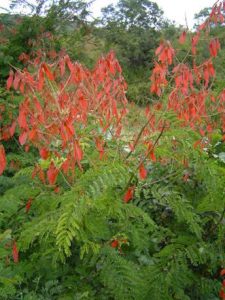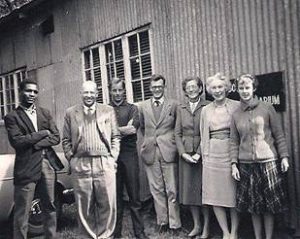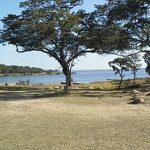TREE LIFE
November 2011
MASHONALAND CALENDAR
Sunday November 20th: Henry Hallam Dam (or Harava Dam)
Directions: Henry Hallam Dam is a delightful spot offering unspoilt woodland close to Harare. We last went there in 2004.
Take the Seke Road towards Chitungwiza. Once at Coke Corner, Graniteside, continue along the Seke Road. Check your speedo at Coke corner and proceed for approx 14km until you reach a turn-off, unsignposted, but notable for the clump of three mature trees growing by it on the left of the road. (If you reach the bridge you have gone too far.) Turn left at the trees and after a short distance you will find a bar called “Miranda Hideout”, and to the left of it a wire fence and gate to the park.
Here you will pay your entrance fee of $2 per person … nothing for the car. From the gate, proceed exactly 5.1km to the parking area on the right, where you will find concrete tables, toilets and a braai area.
The road to the venue is passable with caution, and off-road vehicles are recommended.
We will meet as usual at 0930. Please bring all you need for a picnic lunch.
Saturday November 26th:
This afternoon walk has been cancelled because Mark will not be available.
VISIT TO GOSHO PARK September 18th 2011
The Tree Society was kindly invited by Penny Raynor to visit Gosho Park, the conservation area of Peterhouse a few kilometres past Marondera.
Gosho Park is situated in pristine Miombo forest at an altitude of some 1640 meters. We first congregated at Bush Camp, where we were welcomed by Penny and met a group of youth studying for their Guiding Learner Licence.
The participants were divided in two groups, the young people under the leadership of Meg, and the senescent with Mark.
We drove a few kilometres to a little dam and started our walk. The first thing to attract our attention was a group of Dalbergia nitidula in full bloom, an absolutely magnificent display of white among the fresh green of the surrounding Brachystegia glaucescens (tamarindoides). We noted the presence of two of the three types of Cussonia, Cussonia natalensis and Cussonia spicata; strangely we did not spot any Cussonia arborea even though it should be the most common in this ecosystem.
We then crossed the dam to have a look at the hill behind. We naturally saw Brachystegia spiciformis and boehmii as well as Rhus longipes and tenuinervis (Searsia), Combretum molle, Faurea saligna, Ficus natalensis, Parinari curateliifolia and Syzygium cordatum. The whole area radiates peace and serenity and would be worth more frequent visits. An interesting find was an Apodytes dimidiata, one of the few representatives of the genus Icacinaceae in Zimbabwe. It makes a very nice garden tree with its shiny evergreen foliage, its sweetly scented white flowers and the black and red berries that attract many birds. Black rhinos are said to relish the leaves and bark, so if you plan on having black rhinos visiting your garden go ahead.
In the Celastraceae we noticed Maytenus undata, another evergreen, a hardy garden subject that attracts bulbuls, starlings and barbets.
During the afternoon walk, we came across a Diospyros whyteana (bladder-nut) in fruit, unfortunately badly damaged by the birds that are very fond of the berries. This is another Ebenaceae (the ebony family), other ones seen in Zimbabwe being Diospyros lycioides, mespiliformis, quiloensis, nummularia, senensis and kirkii.
This was a truly delightful venue and one of the diminishing areas where the Miombo forest environment is well protected.
-Jean-Pierre Felu
VISIT TO BUSHMAN’S POINT (LAKE MCILWAINE)
October 16th 2011
Bushman’s Point is situated at the far end of the National Park at an altitude of 1370 meters above sea level, 17°55,155’ South and 30°50.198’ East. The Park is covered by Miombo forest punctuated by rocky outcrops that enhance the biodiversity of the area. Strangely enough (at least for me) typical riverine vegetation is not prominent. One would have thought that, after over 50 years of existence, the shore of the dam would have attracted riverine vegetation. Meg explained that 50 years is not long enough and that the man-induced fluctuations of lake level did not always correspond with natural fluctuations.

Pterolobyum stellatum
Mark started the ball rolling by showing us huge spines on the “trunk” of a Pterolobium stellatum, we then proceeded to a Commicarpus plumbagineus in flower, a very pretty sight indeed and a budding Erythrococca trichogyne. He then handed us over to Meg, our leader for the day.
An interesting sight was a young Ficus burkei already trying its talents at rock splitting.
We also saw an unusual looking creeper, Dioscorea dumatorium, giving the impression of growing upside down in complete contradiction to the laws of gravity, the axils where new growth occur facing downward.
We came across some Allophyllus africanus and learnt an easy way to tell it apart from Rhus: In Allophylus the lateral veins go all the way to the margin and the tip of the teeth (when present). In Rhus they divide before reaching the edge. And by the way, remember that all the Rhus have changed their name to Searsia. Another obscure botanist has achieved notoriety!
Around us was the expected harvest of Brachystegia spiciformis, Gymnosporia senegalensis, Diospyros nummularia, Dombeya rotundifolia, Combretum zeyheri, Euclea natalensis, a prolific number of Grewia flavescens and some Grewia monticola, Maytenus undata, Ochna pulchra, Peltophorum africanum with its beautiful fern-like growing tips, Pterocarpus rotundifolius, Tricalysia niamniamensis, Vitex payos, Vangueriopsis lanciflora and Ximenia caffra.
We also saw a lone Pappea capensis, a tree with a mind of its own … when young the leaves are serrated becoming entire in adults. More exotic is the ability of the male tree to grow male flowers followed by female flowers when, and only when, it deems condition suitable for fruiting. But when it decides to fruit (an infrequent event) the spectacle of the myriad of fruit enveloped in a bright-red aril is spectacular and the jam from it delicious.
We also saw what we believed to be an Albizia harveyi, but sadly no volunteer offered to climb up to get us a leaf.
We all had a very enjoyable outing and it is comforting to walk in a stretch of bush that has been saved from perpetual bush fires.
-Jean-Pierre Felu
FROM THE ARCHIVES

Guess who??
This photograph (an innovation in Tree Life!) is dated April 1963. How many of the people can you identify?
They are left to right – Steven Mavi, Hiram Wild, Tom Muller, Bob Drummond, Lucy (Chippindall) Crook, Joan Fernsby and Rosemary Grosvenor.
And have you got the location? Yes, it is the National Herbarium.
Many thanks for the photo to Nina Bauer, whose mother is Joan Fernsby (second from right).
STRENGTHEN MEASURES TO PROTECT FORESTS: FAO
Countries across the globe have been challenged to better manage and conserve the forests in their areas as one of the commitments to the Millennium Development Goals (MDGs).
According to a comprehensive forest review released in March last year by the Food and Agriculture Organization (FAO), the rate of deforestation has slowed over the last 10 years, but each year an area roughly the size of Costa Rica is still destroyed.
“For the first time, we are able to show that the rate of deforestation has decreased globally as a result of concerted efforts taken both at local and international level,” said Eduardo Rojas, Assistant Director of FAO’s Forestry Department, referring to the agency’s Global Forest Resources Assessment 2010.
Between 2000 and 2010, some 13 million hectares of forests were converted annually to other uses, such as agriculture, or lost through natural causes. This is down from 16 million hectares per year during the 1990s, according to the assessment, which surveyed 233 countries and areas.
Ambitious tree-planting programmes in countries such as China, India, the United States and Viet Nam–combined with natural expansion of forests in some regions–have added more than 7 million hectares of new forests annually, the review noted.
In addition, it said Brazil and Indonesia, which had the highest loss of forests in the 1990s, have significantly reduced their deforestation rates.
“Not only have countries improved their forest policies and legislation, they have also allocated forests for use by local communities and indigenous peoples and for the conservation of biological diversity and other environmental functions,” Mr. Rojas said.
“This is a very welcoming message in 2010, the International Year of Biodiversity,” he added highlighting the UN-designated year meant to spotlight preservation of efforts for the world’s diverse animal and plant species.
Despite the declining trend, the area of primary forest–or forests undisturbed by human activity–continues to decrease, Mr. Rojas said, calling on countries to strengthen their efforts to better conserve and manage them.
The world’s total forests—at just over four billion hectares, or 31 percent of the total land area—play an important part in climate change mitigation. Forests store a vast amount of carbon. When a forest is cut down and converted to another use, carbon is released back into the atmosphere.
Ensuring environmental sustainability is one of the Millennium Development Goals, an internationally recognised blueprint to alleviate poverty by 2015.



